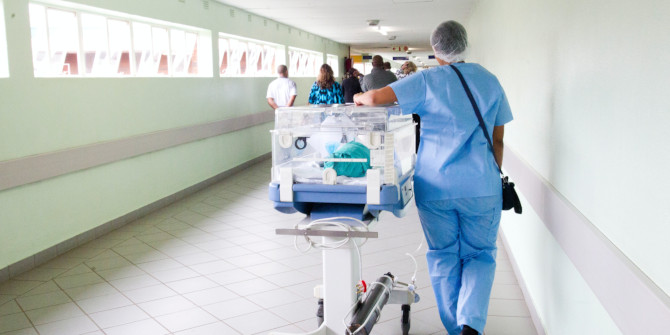In Pandemic Solidarity: Mutual Aid during the Covid-19 Crisis, Marina Sitrin and Colectiva Sembrar explore how communities in different areas of the world mobilised to help one another during the COVID-19 pandemic through mutual aid. Showing the power of extra-institutional solidarity networks, this book helps us to rethink and re-imagine an egalitarian society where no one is left behind, writes Emmanuel Durosinmi.
Pandemic Solidarity: Mutual Aid during the Covid-19 Crisis. Marina Sitrin and Colectiva Sembrar (eds). Pluto Press. 2020.
 Find this book (affiliate link):
Find this book (affiliate link): ![]()
In Pandemic Solidarity, Marina Sitrin and Colectiva Sembrar examine how COVID-19 has introduced an overarching fear that has rarely been witnessed at such a collective level. In the introduction, which sets a precedent for subsequent chapters, Sitrin views the pandemic as a reflection of the structural inequalities and systemic oppression that our societies were built upon, privileging the very few and pitting the rest of society against one another.
However, given the complexity of the COVID-19 pandemic with its attendant restrictions and safety precautions, it has also inspired arguably the largest and most diverse mobilisation of people helping one another under capitalism. The contributors to this volume combine ‘face-to-face computer mitigated discussion’ and ‘ethnographic interviews’ as research instruments to examine the coping strategies of people in the Middle East (Rojava, Turkey, Iraq), South and East Asia (Taiwan, South Korea, India), Southern Africa (Mozambique, South Africa, Zimbabwe), Europe (Portugal, Greece, Italy, the UK) and North and South America (Turtle Island, Argentina, Brazil) during the COVID-19 pandemic.
Emre Sahin and Khabat Abbas in Chapter One examine how people’s access to decision-making processes through ‘communes’, ‘district councils’ and ‘municipalities’ saved the lives of vulnerable citizens of the Autonomous Administration of North and East Syria (AANES) during the pandemic. The authors use phone interviews to unravel the coping strategies of AANES against the harsh economic realities of the pandemic. Five phone interviews were conducted with active participants involved in mutual aid, relief and solidarity efforts in Qamishlo, north-east Syria. The interviews reflected the voices of people of different genders, ages, ethnicities and those experiencing different forms of local governance. The responses were organised into four thematic areas: security, health, education and local governance.
Drawing from the chapter’s analysis, it’s crystal clear that AANES had been making conscious efforts towards the provision of social welfare services to its citizens prior to the emergence of the pandemic. As noted in the chapter, AANES was able to operate an effective lockdown policy due to its practice of ‘democratic confederalism’, described as a ‘multicultural, anti-monopolistic, consensus-oriented and flexible political administration which allows communities direct involvement in decision-making processes, enables people to act outside the confines of social and capitalist relations (competition and self-interest) and also increases political agency’ (4-5).
This study makes two pertinent points which subsequent research could explore further. First, states have the capacity to innovate during crises and disasters. The analysis demonstrates a number of innovations by the people of AANES during the pandemic, including the development of a programming database for effective patient record-keeping, the production of face masks by a local women’s cooperative, the development of sterilisation cabinets to measure patients’ temperatures, the development of a local respirator with advanced features and the transition from classroom to online teaching.
Second, the authors of the chapter argue that there’s a higher tendency for people who have lived under protracted conflict situations to cope during a pandemic or natural disaster compared to societies with less violent conflict. Amidst the pandemic-induced infections, the people of AANES were under fear of Syrian and Turkish invasion, due to previous invasions in Afrin, Serekaniye and Gire Spi. By implication, the familiarity with quarantine measures under war and conflict situations with their neighbours paved the way for the people of AANES to integrate the lockdown policy into their daily routines without protest. However, this security situation with the Syrian and Turkish regimes was a major challenge for AANES in managing the spread of infections during the pandemic as there were cases of cross-border smuggling of goods and people and the destruction of key sanitation infrastructure, such as water stations.
Seyma Ӧzdemir in Chapter Two explores the coping strategies of Turkey during the pandemic through the lens of solidarity networks. How does the state successfully implement a lockdown policy in an unequal society characterised by chronic disease, extreme poverty, homelessness and wanton human rights violations? This is a question vehemently challenged through the proliferation of solidarity networks in Turkey and other countries examined in this book.
As a departure from AANES, two dynamics play out in the context of the Turkish response to the pandemic. First, the state views solidarity networks as a threat capable of exposing the government, its incompetence, its problems and its intentions as well as its unwillingness to support people with welfare packages. As a consequence, this led to the use of force to silence those challenging the authority of the state. Second, the extra-institutional activities of the solidarity networks, which Ӧzdemir deems ‘re-imagined and unimagined spaces’ (20), show the tendency of ordinary people to create solutions to problems outside of institutional channels.
Similarly, the extra-institutional activities of social movements in Mozambique, South Africa and Zimbabwe challenged the repressive character of the state during the pandemic through civil society alliances, diaspora solidarity, anti-xenophobic and regional solidarity. This lends credence to the capacity of ordinary people to transform, reform and challenge the state, as examined by Boaventura Monjane in Chapter Seven.
In contrast, Midya Khudhur in Chapter Three explains that war-torn Iraq experienced harmony between the government and the people given the invisibility of the enemy (COVID-19). Iraq has a long history of battling with a physical enemy in the theatre of conflict prior to the emergence of COVID-19 with consequences for its economy and population. This history has given rise to poverty, unemployment and a lack of trust in governance. During the pandemic, the invisibility of the enemy rendered the state powerless, changed the dynamics of social relations and saw the proliferation of solidarity networks, which in the case of Iraq has served as a complement to the efforts of government in providing welfare services to people.
In Chapters Four, Five, Six and Twelve, Chia-Hsu Jessica Chang, Ji Young Shin, Debarati Roy and carla bergman et al explore how the pandemic has re-established social segregation and exclusion in the form of individualised bodies and border spaces created under colonialism. However, they argue that the pandemic-induced social stratification has also promoted shared spaces, social bonds and re-imagined social relations, solidarity and mutual aid support across borders and territories, which have helped people to cope amidst fear of the virus in Taiwan, South Korea, India and Turtle Island respectively.
Similarly, the collaborative efforts of solidarity networks (comprising medical practitioners, security officers, volunteer workers, journalists, disability activists, the transgender community, unhoused people, student networks, prisoner solidarity, indigenous people, immigrant communities, online mutual aid networks and restaurant associations) took on different dynamics in South and East Asia as well as Turtle Island. These networks defied social distancing and lockdown policies to respond to the outcries and vulnerability of the poor, social contract workers, psychiatric patients, disabled people, homeless people and ageing populations unable to carry out their daily routines or feed without the support of a caregiver.
In Chapters Eight, Nine, Ten, Eleven, Thirteen and Fourteen, Lais Gomes Duarte and Raquel Lima, Eleanor Finley, EP and TP, Neil Howard, Nancy Viviana Pineiro and Liz Mason-Deese, and Vanessa Zettler reveal the classist, patriarchal and racist exploitation introduced under capitalism, which is reproducing inequalities in Portugal, Italy, Greece, the UK, Argentina and Brazil. By implication, this has worsened the plight of vulnerable people during the pandemic. Drawing from their analyses, one learns that the coming together of diverse people, groups and associations during emergency situations is very possible. However, it’s unclear whether such a positive collective identity witnessed in these countries and elsewhere during the pandemic could be realised in similar emergency situations in the post-pandemic era.
This book unravels the evils of colonial border spaces and capitalism but also opens our eyes to the hidden humanity in our societies. It exposes the weaknesses of the state in addressing an invisible enemy which has no regard for status, class, age, ethnicity, gender, colour and location. The book shows, among other things, that states cannot solve all human problems and the extra-institutional activities of solidarity networks, as seen throughout this book, show us that the solutions to some of our problems are best addressed outside of institutional channels. The book also reveals the capacity of solidarity networks to reform, transform and challenge existing political authorities. Pandemic Solidarity helps us to rethink and re-imagine an egalitarian society where no one is left behind. I recommend the book to development practitioners, government functionaries, academics and students of social policy and political science.
Note: This article first appeared at our sister site, LSE Review of Books. It gives the views of the author, not the position of EUROPP – European Politics and Policy or the London School of Economics. Featured image credit: Joel Muniz on Unsplash





